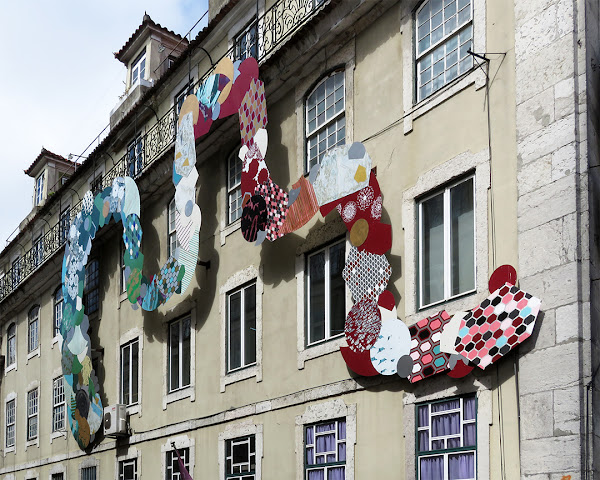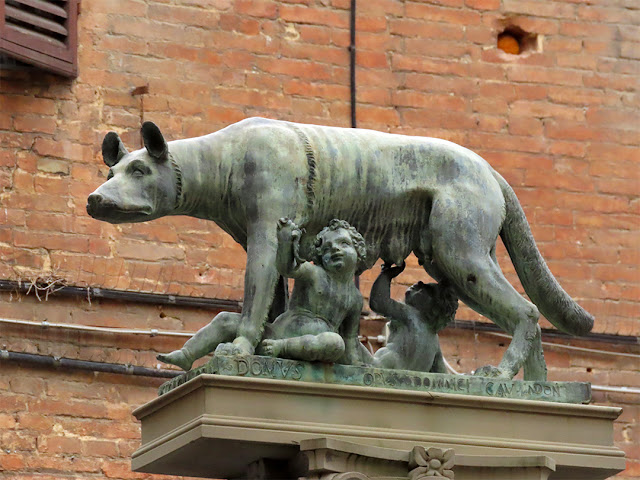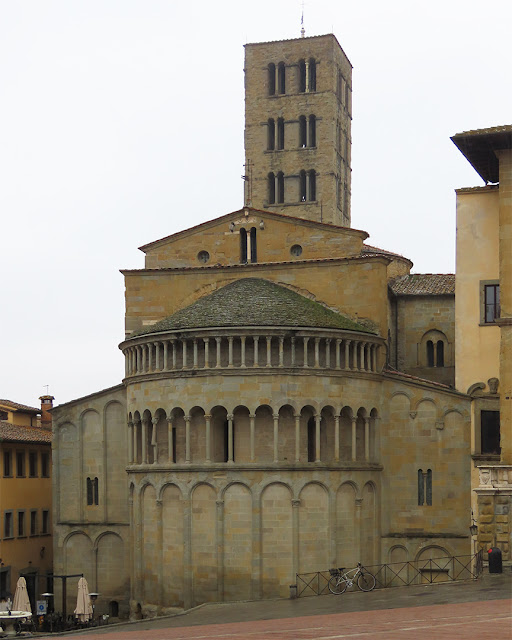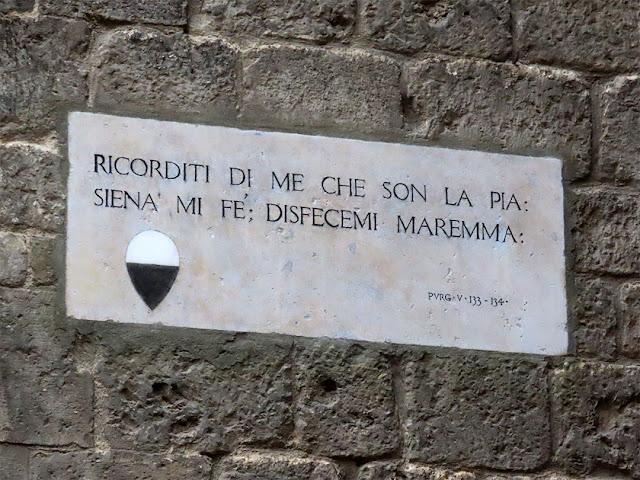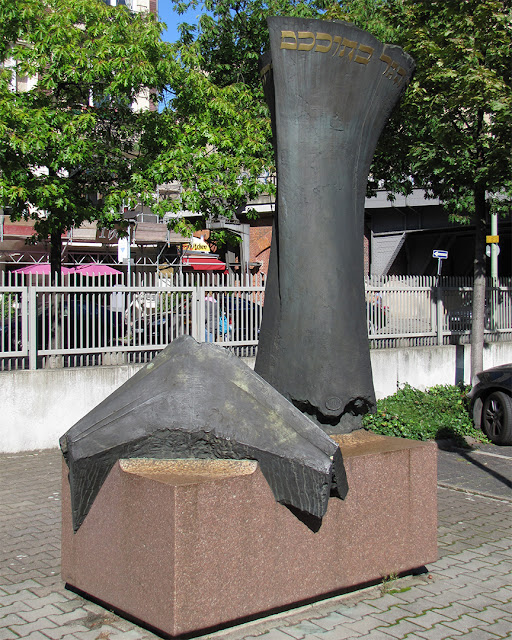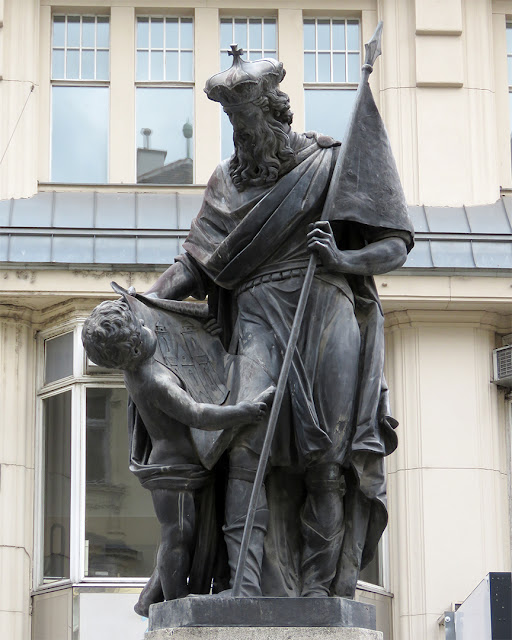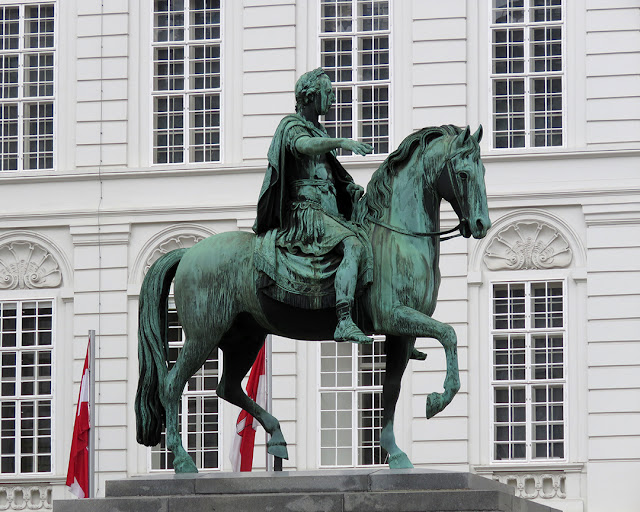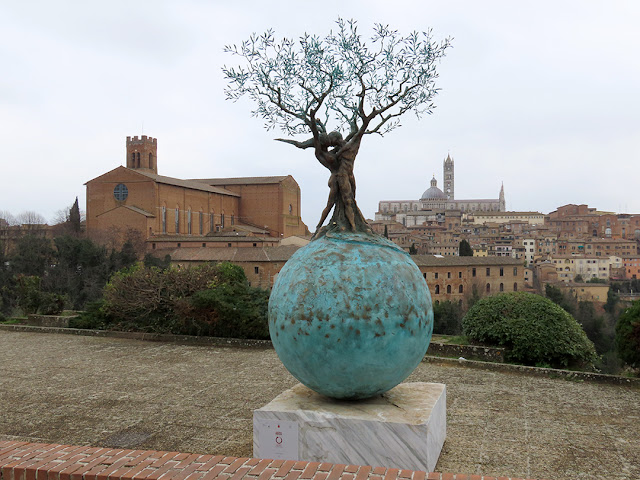Saturday, April 29, 2023
Fonte Pubblica
Fonte Pubblica (Public Fountain)
Piazza Grande
Arezzo, February 2022
“In his Nuova Guida per la città di Arezzo, Oreste Brizi states that the Public Fountain is situated on the left of Piazza Grande and supplied by waters which travel for more than a mile from the aqueduct and the Fortress Hill tunnel. The adductor aqueduct and tunnel were realised in 1600 on a plan and under the direction of engineer Santi di Pagni. The fountain in Piazza Grande supplied the Public Fountain and the horse trough in via Sant’Agostino and «the water reached there after serving various wheat mills situated between one fountain and the other», as well as a wash-house on the same street, ‘the water of which then gave motion to the millstones of other mills in the city’.” (Public Fountain of Arezzo, IMSS)
Friday, April 28, 2023
Mamba de Jameson
“Mamba de Jameson” (Jameson's mamba) by Ateliê Contencioso, 2015
Pensão Amor
Rua Nova do Carvalho
Lisbon, April 2019
“We head to Rua Rosa, in Cais do Sodré, the centre of Lisbon’s nightlife. The Lisbon’s Snake Woman runs across the entire façade of Pensão Amor, a place that used to hold burlesque shows and nowadays is a dance floor for old and new hits. Ateliê Contencioso – formed by visual artists Ana Velez, Joana Gomes, Maria Sassetti and Xana Sousa – was inspired by the story of a beautiful and brave prostitute, named Destemida (Fearless), who fell in love with an Irish sailor, Thomas. This sailor had a magic beverage, the drink of happiness. Just a few sips of this golden liquid would bring a renewed life to any man. Afraid that the beverage would run out, men started spreading the rumour that if any woman took a sip of that liquid, she would cry for the rest of her life. They all believed it, except for Destemida. Be it for their immense beauty or for too much sips of the magic liquid, Thomas and Destemida lived a blind passion. For weeks no one saw them, and rumours about Destemida’s power of enchantment grew among the people. But one day, Destemida woke up alone. She went mad. She went out to the street naked, wearing nothing but a crochet shawl, that she had since she was a child. She searched in Taverns, alleys, decks and other beds, but she found no sign of the Irishman. Desperate and not knowing where to go, Destemida turned into fish scales and feathers to search through sea and air for her sailor. For 150 moons she travelled the earth in a vain search, and when she gave up, she became the Jameson’s Mamba snake, sliding through the trees of the peer until she curled around the room in Pensão Amor where they loved each other. To this day, whenever the Lisbon´s Snake Woman senses the crowds around Rua Rosa, she gazes around hopping to see her lover.” (Lisbon’s Snake Woman in Cais do Sodré Pink Street, BestExperience Lisbon)
Thursday, April 27, 2023
Wednesday, April 26, 2023
Tuesday, April 25, 2023
Apse of Santa Maria della Pieve
Apse of Santa Maria della Pieve
Piazza Grande
Arezzo, February 2022
“The 13th century apse has also two rows of loggia which recall the façade's structure, repeating the use of different style capitals. The sides have mullioned windows.” (Santa Maria della Pieve, Wikipedia)
Monday, April 24, 2023
Josef Ressel
Statue of Josef Ressel by Anton Dominik Fernkorn, 1863
Resselpark, Karlsplatz
Vienna, June 2018
“Joseph Ludwig Franz Ressel (Czech: Josef Ludvík František Ressel; June 29, 1793 – October 9, 1857) was a forester and inventor of Czech-Austrian descent, who designed one of the first working ship's propellers. He worked for the Austrian government as a forester in the more southern parts of the monarchy, including in Motovun, Istria (modern-day Croatia). His work was to secure a supply of quality wood for the Navy. He worked in Landstrass (Kostanjevica on the Krka river in Carniola in modern-day Slovenia), where he tested his ship propellers for the first time. In 1821 he was transferred to Trieste (modern-day Italy), the biggest port of the Austrian Empire, where his tests were successful. He was awarded a propeller patent in 1827. He modified a steam-powered boat Civetta by 1829 and test-navigated it in the Trieste harbor at six knots before the steam conduits exploded. Because of this misfortune, the police banned further testing. The explosion was not caused by the propeller being tested, as many believed at the time.” (Josef Ressel, Wikipedia)
Sunday, April 23, 2023
Pia de' Tolomei
Plaque remembering Pia de' Tolomei
Palazzo Tolomei
Vicolo della Torre
Siena, February 2022
“Ricorditi di me, che son la Pia;
Siena mi fé, disfecemi Maremma:
salsi colui che 'nnanellata pria
disposando m'avea con la sua gemma.”
(Purgatorio V, 133-136)
(Please remember me, who am La Pia.
Siena made me, in Maremma I was undone.
He knows how, the one who, to marry me,
first gave the ring that held his stone.)
(Purgatory V, 133-136)
“Pia de' Tolomei was an Italian noblewoman from Siena identified as ‘la Pia,’ a minor character in Dante's Divine Comedy who was murdered by her husband. Her brief presence in the poem has inspired many works in art, music, literature, and cinema. Her character in the Divine Comedy is noted for her compassion and serves a greater program among the characters in her canto, as well as the female characters in the entire poem.” (Pia de' Tolomei, Wikipedia)
Saturday, April 22, 2023
Friday, April 21, 2023
One hundred holes
“One hundred holes” bell tower
Santa Maria della Pieve
Corso Italia
Arezzo, February 2022
“The bell tower has a sturdy appearance with five rows of mullioned windows. Internally, the base houses the baptistery. The baptismal font dates to the 14th century, and has panels with Stories of St. John the Baptist by Giovanni d'Agostino (1332–1333).” (Santa Maria della Pieve, Wikipedia)
Thursday, April 20, 2023
António Ribeiro Chiado
“António Ribeiro Chiado” by Costa Mota (tio), 1925
Largo do Chiado
Lisbon, April 2019
“António Ribeiro O.F. (Évora, 1520 – Lisbon, 1591), known as O Chiado or O Poeta Chiado was a Portuguese poet. O Chiado was a satirical poet of the sixteenth century, contemporary of Luís Vaz de Camões. He was known as Chiado for having lived many years in Chiado, Lisbon, in the street so called already in the sixteenth century (today Rua Garrett).” (António Ribeiro Chiado, Wikipedia)
Wednesday, April 19, 2023
Tuesday, April 18, 2023
Monday, April 17, 2023
Santa Maria della Pieve
Santa Maria della Pieve
Corso Italia
Arezzo, February 2022
“The church's most striking feature is its façade, with a five-arch lower floor surmounted by three loggias, with the number of columns increasing with the elevation. The columns, and its capitals, are each different from the other (one is a statue). The original façade had no particular features, the current decoration having been added in the 12th century.” (Santa Maria della Pieve, Wikipedia)
Sunday, April 16, 2023
Leopoldsbrunnen
Leopoldsbrunnen (Leopold's Fountain) by Johann Frühwirth, 1680/1804
Graben
Vienna, June 2018
“The second, southwestern, fountain was presumably built in 1561. When in 1638 it was decided to establish new fire regulations, new fountains on the Freyung and the Graben were likewise deemed necessary. The two fountains were therefore rebuilt. At the behest of Leopold I, the fountains were adorned with sculptures of Saints Joseph and Leopold, which were executed by the sculptor Johann Frühwirth. These were later replaced with lead figures by Johann Martin Fischer. Frühwirth's statues have since been lost.” (Graben, Wikipedia)
Saturday, April 15, 2023
Friday, April 14, 2023
Thursday, April 13, 2023
Church of San Michele
Church of San Michele
Piazza San Michele
Arezzo, February 2022
“This church has a modern façade. Traces of the original Romanesque edifice and the Gothic restoration can be seen in the interior.” (Arezzo, Wikipedia)
Wednesday, April 12, 2023
Maternidade
“Maternidade” (Motherhood) by Fernando Botero, 1999
Jardim Amália Rodrigues
Alameda Cardeal Cerejeira
Lisbon, April 2019
Tuesday, April 11, 2023
Monday, April 10, 2023
Gatekeeper
“Torwächter” (Gatekeeper) by Stephan Balkenhol, 2003
CityQuartier DomAquarée
Karl-Liebknecht-Straße
Berlin, September 2011
Sunday, April 9, 2023
Church of St. Augustine
Church of St. Augustine, 1766
Piazza di Sant'Agostino
Arezzo, February 2022
“Church of St. Augustine, founded in 1257, modified in the late 15th and the late 18h centuries. The façade and the interior decoration are largely from Baroque times. The square plan bell tower is from the 15th century.” (Arezzo, Wikipedia)
Saturday, April 8, 2023
Kaiser-Joseph-Denkmal
Monument to Emperor Joseph II by Franz Anton von Zauner, 1807
Josefsplatz
Vienna, June 2018
“Josefsplatz is centred on a full-sized equestrian statue and monument of Emperor Joseph II, erected by sculptor Franz Anton von Zauner between 1795 and 1807. Modelled on the statue of Marcus Aurelius on Capitoline Hill in Rome, the statue was commissioned by Emperor Francis II who, from the age of 16, had been raised under the supervision of his uncle, Joseph II. The depiction of Joseph II as a Roman conqueror, dressed in a toga and a laurel wreath, reflects the Habsburg belief that they were descendants of the ancient Roman emperors.” (Josefsplatz, Wikipedia)
Friday, April 7, 2023
L'amore salva il mondo
“L'amore salva il mondo” (Love Saves the World) by Andrea Roggi, 2017
Belvedere di San Prospero
Siena, February 2022
Thursday, April 6, 2023
Torwächter
“Torwächter” (Gatekeeper) by Stephan Balkenhol, 2003
CityQuartier DomAquarée
Karl-Liebknecht-Straße
Berlin, September 2011
Wednesday, April 5, 2023
Monument to Mecenate
Monument to Mecenate, early 19th Century
Via Margaritone
Arezzo, February 2022
“Nineteenth century marble copy of a bust, preserved in the Capitoline Museums in Rome, that at the time was believed an ancient portrait of Mecenate, then recognized as a modern work. The portrait bust, made in Rome, was donated to the Municipality of Arezzo in 1834 and exhibited in the Town Hall on top a granite column. In 1937 the monument was relocated to the area of the Roman Amphiteater, as ornament at the entranmce of the Archeological Museum ‘Gaio Cilnio Mecenate’. Mecenate (68-8 BC?), born in Aretium from a noble Etruscan family, was trusted advisor to Octavianus Augustus, first Emperor of Rome, and patron of the greatest poets and artists of the time.” (Monumento a Mecenate, Polo Museale della Toscana)
Tuesday, April 4, 2023
BBVA Portugal
Banco Bilbao Vizcaya Argentaria by António Augusto Moreira Nunes de Almeida, 1988
Avenida da Liberdade
Lisbon, April 2019
“Avenida da Liberdade (Avenue of Liberty) is a boulevard in central Lisbon, Portugal, is the most expensive street to rent or buy property on in Portugal. Originating in the Passeio Público, an 18th-century park built for the Portuguese nobility, the avenue was built in 1879, when the former park was turned into a major boulevard, marking the northward expansion of the city during the 19th century. The Avenida is also home to numerous embassies and diplomatic missions.” (Avenida da Liberdade, Wikipedia)
Monday, April 3, 2023
Fallen for the Independence
Monument to the Fallen for the Independence by Tito Sarrocchi, 1879
Viale Fruschelli
Siena, February 2022
Sunday, April 2, 2023
Neptune and the Rhine
Detail of Neptune and the Rhine
Neptunbrunnen (Neptune Fountain) by Reinhold Begas, 1891
Rathausstraße
Berlin, September 2011
“The Neptune Fountain (Neptunbrunnen) in Berlin was built in 1891 and was designed by Reinhold Begas. The Roman god Neptune is in the center. The four women around him represent the four main rivers of Prussia at the time the fountain was constructed: the Elbe (with the allegorical figure holding fruits and ears of corn), Rhine (fishnet and grapes), Vistula (wooden blocks, symbols of forestry), and Oder (goats and animal skins). The Vistula is now entirely in Poland, while the Oder forms the border between Germany and Poland. The fountain was removed from its original location at the Schlossplatz in 1951, when the former Berliner Stadtschloss (Berlin City Palace) there was demolished. Eventually, after being restored, the fountain was moved in 1969 to its present location between the St Mary's Church and the Rotes Rathaus. The diameter is 18 m (59 ft), the height is 10 m (33 ft). There was another well-known Neptunbrunnen in Breslau (nicknamed ‘Gabeljürge’ or ‘Georgie Fork’ by the locals), but it was destroyed during World War II and the city was later transferred to Poland.” (Neptunbrunnen, Wikipedia)
Saturday, April 1, 2023
Roman amphitheatre
Roman amphitheatre
Via Margaritone
Arezzo, February 2022
“The Roman Amphitheater is the largest archaeological site in Arezzo. It sits in the southern area of the walled city. Over the centuries, it has been left in disarray and been looted of its treasures. Churches and buildings have been built over it as well. Today what is left of the Amphitheater are pathways made of brick and sandstone as well as arches and the two main entrances. Despite the fact that few features remain of the Amphitheater, it hasn’t lost its grandeur. It was founded in the Hadrian age, between 117 and 138 AD, is little slightly than the Coliseum with a greater axis 121 meters long and a lesser axis 68 meters long. The Roman Amphitheater was built for events and celebrations in Arezzo. It could hold up to eight thousand people. Today it hosts events, shows and outdoor concerts in the summer. Its history and the numerous artifacts of the Roman era of Arezzo are displayed at the Archaeological Museum Giao Cilnio Mecenate which is adjacent to the amphitheater.” (The Roman Amphitheatre, Discover Arezzo)
Subscribe to:
Posts (Atom)



